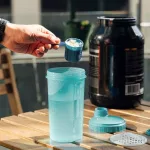Defective dimmer switches represent the most significant documented hazard linked to Himalayan salt lamps. Some models were recalled after overheating and catching fire. Other concerns include risks to pets (from ingesting salt) and potential for corrosion.
Himalayan salt lamps are admired for their rosy tones, organic contours, and widely promoted wellness effects. Proponents claim they emit negative ions that cleanse the air and create a soothing atmosphere in your home.
Although these lamps are generally regarded as safe, there are a few hazards to be aware of if you plan to use one. Continue reading to learn more about these fixtures and how to keep them safe around the house.

What is a Himalayan salt lamp?
Himalayan salt lamps are lumps of salt crystal lit from within by electric bulbs. Many people appreciate their subdued, sunset-like illumination as calming and visually appealing.
Supporters assert the lamps purify indoor air and offer health perks such as improved mood, better sleep, and easier breathing. The premise is that the lamps alter the ion balance in the surrounding air, reducing allergy symptoms and aiding respiratory comfort.
While some evidence suggests that substantial concentrations of negative ions might influence certain health issues, researchers note that the amount of negative ions produced by salt lamps is far too low to deliver measurable health advantages.
Even without strong scientific backing for the health claims, these lamps remain popular decorative pieces, so it’s helpful to understand the potential hazards they can present in domestic settings.
What are the possible dangers of Himalayan salt lamps?
Electrical hazards
Like any electrical appliance, a salt lamp can be a fire risk if its wiring is faulty, damaged, or if the device is misused.
In January 2017, the Consumer Product Safety Commission (CPSC) recalled salt lamps whose dimmer switches were defective and prone to overheating, posing a fire danger. About 80,000 lamps sold under the Lumiere brand were part of that recall.
That same May, an additional 3,900 Lumiere lamps were recalled for the identical hazard. If you have an older salt lamp, it’s worth checking whether it was included in those recalls.
Risk to children
Authentic salt lamps can be heavy — some showpieces weigh as much as 80 pounds. Heavy items placed on elevated surfaces can be hazardous to children because they might topple and injure anyone beneath them.
To reduce the risk of a rock lamp falling and hurting a child, place it out of children’s (and pets’) reach on stable, secure furniture.
Corrosion
Real salt lamps absorb moisture from the air, which can cause condensation to form on their exterior. When the lamp is lit, the heat helps evaporate that moisture.
If the lamp is cool, however, accumulated water can drip onto the lamp’s base or the furniture beneath. If those surfaces are metal, corrosion may occur. If they’re wooden, the moisture could warp or stain the wood.
Although this type of corrosion isn’t a direct health threat, it’s prudent to verify that the bulb isn’t touching the salt crystal. The bulb should sit in a hollow within the rock, away from the edges, to minimize condensation.
Risk to pets: salt poisoning
Himalayan salt lamps can pose a danger to household pets because dogs and cats can be harmed by consuming excessive salt.
Veterinarians caution that cats are especially at risk since they can jump onto tables and shelves to lick lamps. A single lick or two is unlikely to be harmful, but frequent licking could lead to salt poisoning.
If your cat has been repeatedly licking a salt lamp, symptoms of salt poisoning can include:
- vomiting
- diarrhea
- lethargy
- seizures
- death
To prevent accidental salt poisoning, keep your salt lamp where your cat or dog cannot access it.
How to tell authentic Himalayan salt lamps from imitations
True Himalayan salt lamps are sourced from the Khewra (Mayo) salt mine, one of the oldest and largest mines in Pakistan’s Punjab. Salt from these mines has a characteristic pink glow, often with white or deeper red streaks.
When buying a salt lamp, check the labeling to see where the product was produced.
Genuine lamps have a matte finish and emit a gentle, muted light. Lamps with a glossy surface and a bright shine are likely not true Himalayan salt. Because authentic lamps are made of salt, they can chip or break if dropped; imitations tend to be more impact-resistant.
A simple moisture check: a real salt lamp will “sweat” in humid conditions. Wiping a genuine lamp with a damp cloth should leave some pink mineral residue on the cloth.
Tips for using salt lamps safely
When purchasing, opt for an authentic lamp that carries a UL safety mark or equivalent, indicating its wiring has been inspected. Ensure the dimmer switch and cord are secure and not loose. Also verify the bulb does not contact the salt crystal.
Think about child and pet safety when choosing the lamp’s location. Place it on a stable surface out of reach of even the most inquisitive pets.
Turn the lamp on regularly so moisture does not build up.
Bottom line
Himalayan salt lamps, with their warm pink-orange glow and rustic form, are popular decorative choices.
Some claim they enhance air quality, improve sleep, and boost mood. These benefits lack robust scientific confirmation — and the associated risks are not fully established.
The clearest documented hazard involved lamps with faulty dimmer switches that were recalled because they could overheat and catch fire.
Other concerns include the substantial weight of some lamps, which could cause injury if they topple from an unstable surface, and the risk of salt poisoning for pets — particularly cats that repeatedly lick the lamps.
To minimize these risks, use lamps with certified, properly installed wiring. Position them on secure, out-of-reach surfaces. Prefer lamps made from authentic Pakistani salt and bought from reputable sellers.
Whether you’re drawn to a Himalayan salt lamp for its aesthetic charm or the suggested wellness effects, ensuring the product is safe and properly placed will help you enjoy it worry-free.


















Leave a Reply
You must be logged in to post a comment.